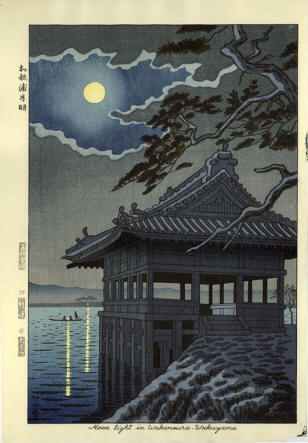Syllabus for Wintermester: 2012

Spirituality
and
the
Living
World
in
the
Shingon
and
Shinto
Traditions
PACKING FOR TRIP:
Obtain one of the following books (available at Amazon.com) and bring it with you on the journey:
Teachings of the Earth by John Dado Loori
The Soul of the World: A Modern Book of Hours by Phil Cousineau
The Art of Pilgrimage: The Seeker's Guide to Making Travel Sacred by Phil Cousineau
Notebook and writing instruments (packed in a ziploc baggie)
Outerwear (it may get cold and wet, so the following are to keep you as comfortable as possible on the trail): waterproof jacket, waterproof pants, waterproof shoes; hat and gloves; a warm layer such as a fleece jacket or parka.
Other items: sweater and/or fleece/ polypro shirts; lighter weight shirts for first layer; long pants; one "dress-up" ensemble, bathing suit; casual shoes; pajamas; undies; towel; toiletries (packed in ziploc baggies). Waterbottle (will need to be empty to go through security).
Optional: camera, travel clock, calculator (or cell phone with these and battery charger); glasses, folding umbrella, small gifts, maps, personal first-aid and medications, snacks.
Money for "meals on your own," going out, and souvenirs ($500.00-1000.00)
All of the above should be packed in one small carry-on sized suitcase and one small backpack (bookbag sized) for the trail. Our luggage will be transported for us while we are on the trail.
COURSE WORK:
Phase 1, pre-travel readings and discussion questions:
Answers should be a paragraph or two in length. Answers are to be submitted via MyClasses course site no later than 5pm on Dec. 28th.
 1. What is the Kumano Kodo trail and where is it
located? Required reading: Sacred
Sites and Pilgrimage Routes in the Kii Mountain Range - UNESCO World Heritage Centre
1. What is the Kumano Kodo trail and where is it
located? Required reading: Sacred
Sites and Pilgrimage Routes in the Kii Mountain Range - UNESCO World Heritage Centre
2. Please give an overview of religion in Japan. What are the main religions practiced? Required reading Religion in Japan (wikipedia)
3. What is the Shinto religion? What are the main precepts? Required reading: Shinto - Wikipedia
4. Give a brief history of Buddhism. Who founded it? Where and when? What are the precepts? Required reading: LIFE OF BUDDHA
5. Using the Web research Zen and Shingon Buddhism. Compare and contrast these two Japanese traditions of Buddhism.
6. Read "Dongshan and Shensen Cross the River" by John Daido Loori. Required reading: (Mountains Waters). What is your favorite line in this article and why?
7. Read "The records of a travel worn satchel" by Basho. Then take a walk outside and compose a Basho-style poem. Write your poem here. Required reading: (Basho) (Image to the left is of one of the stopping points of Basho's journey, a location inside the city limits of current day Wakayama).
8. In "The Life and Legend of Kobo Daishi (Kukai)", pg 56, is written, "Intrinsic to Kukai's argument is his perception that the primal "language" of ultimate reality -- that is, of the Dharma Buddha -- is communicated by nature in its varied phenomenal manifestations. In short, phenomenal nature as perceived by the enlightened mind is the Dharma Buddha." What do you think this means? Please give an example. Optional reading: (Kaukai's Life)
9. In Dogen's "Mountains and Waters as Sutras (Sansui-Kyo)," by Graham Parkes, pg 87, is written, "If you doubt mountains' walking, you do not know your own walking." What do you think this means? Optional reading: (Mountain River Sutra)
10. Do you have what you would consider an "environmental spirituality"? If so, does it have anything to do with your religion (if you have one)? Please expound.
Additional Recommended Readings:
”Walking”: an essay by Henry David Thoreau.
William Edelglass on Joanna Macy and Buddhist Ecology
Stanford Encyclopedia Article on “Kukai”
Kumi Kato:
Spiritual Practice and World Heritage Areas
Phase 2, the journey:
Be where you are supposed to be, when you are supposed to be there.
Be cheerful and kind toward fellow students and faculty; no whining.
Make the most of your time abroad. Think deeply. Read and reflect on your text:
Teachings of the Earth by John Dado Loori
The Soul of the World: A Modern Book of Hours by Phil Cousineau
The Art of Pilgrimage: The Seeker's Guide to Making Travel Sacred by Phil Cousineau
Keep an intellectual journal, writing at least a page a day. Consider making photographs, drawings, and other items, a part of your journal.
Participate in the community service
projects occurring as part of our 3 day stay in Chikatsuyu.
Participate in the conference occurring the final two days of our trip to Japan.
Walk the Kumano Kodo Pilgrimage Route and the Choisimichi (trail to Koyosan).
Phase 3, the return:
You have one week from your return date to complete and turn in a journal of at least 14 pages. This journal should address the spirituality of the living world as experienced by Shinto, Zen, Shingon, and possibly your own personal religious practices. Poems, prose, and images may all be used in the journal. Due date is 11:30pm on Jan 24th.
25% - pre-travel readings and discussion (phase 1)
25% - participation (phase 2)
50% - final journal (phase 3)